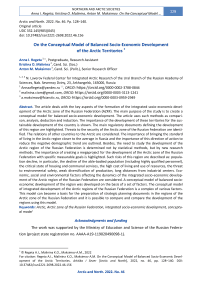On the Conceptual Model of Balanced Socio-Economic Development of the Arctic Territories
Автор: Regeta A.I., Malinina K.O., Maksimov A.M.
Журнал: Arctic and North @arctic-and-north
Рубрика: Northern and arctic societies
Статья в выпуске: 46, 2022 года.
Бесплатный доступ
The article deals with the key aspects of the formation of the integrated socio-economic development of the Arctic zone of the Russian Federation (AZRF). The main purpose of the study is to create a conceptual model for balanced socio-economic development. The article uses such methods as comparison, analysis, deduction and induction. The importance of the development of these territories for the sustainable development of the country is shown. The main regulatory documents defining the development of this region are highlighted. Threats to the security of the Arctic zone of the Russian Federation are identified. The relations of other countries to the Arctic are considered. The importance of bringing the standard of living in the Arctic region closer to the average in Russia and the importance of this direction of action to reduce the negative demographic trend are outlined. Besides, the need to study the development of the Arctic region of the Russian Federation is determined not by statistical methods, but by new research methods. The importance of creating a megaproject for the development of the Arctic zone of the Russian Federation with specific measurable goals is highlighted. Such risks of this region are described as: population decline, in particular, the decline of the able-bodied population (including highly qualified personnel), the critical state of housing and communal services, the high cost of living and use of resources, the threat to environmental safety, weak diversification of production, long distances from industrial centers. Economic, social and environmental factors affecting the dynamics of the integrated socio-economic development of the Arctic region of the Russian Federation are considered. A conceptual model of balanced socio-economic development of the region was developed on the basis of a set of factors. The conceptual model of integrated development of the Arctic regions of the Russian Federation is a complex of various factors. This model can become a basis for the preparation of strategic planning documents in the regions of the Arctic zone of the Russian Federation and it is possible to compare and compare the development of the regions using this model.
Arctic, Arctic zone of the Russian Federation, integrated socio-economic development, conceptual model
Короткий адрес: https://sciup.org/148323970
IDR: 148323970 | УДК: 332.145(985)(045) | DOI: 10.37482/issn2221-2698.2022.46.156
Текст научной статьи On the Conceptual Model of Balanced Socio-Economic Development of the Arctic Territories
The basis of the socio-economic balance of the state is the successful policy of the regions as constituent parts of the country. The state economy will be stable and competitive only with a balanced development of all its regions [1, Lundberg H., Pasillas M., Högberg A., pp. 23–40]. This is of particular importance for the Russian Federation with the diversity of its climate, natural resources, culture and population. Each region, with its relative independence from the center, faces a problem: how to distribute resources in the conditions of deficit and uncertainty in the best way, while increasing budget revenues, investment attractiveness of the region, real income of the population, reducing socio-political risks and solving the social problems of the region [2, Ignatova T.V., Pavlyukova A.V., pp. 171–173]. One of the main tasks of the state today is the most efficient redistribution of excess profits from the export of energy resources and the concentration of resources in innovative industries [3, Vaisman E.D., Boos V.O., pp. 130–139]. The Russian Federation has the longest Arctic coast, and the country needs to make great efforts to develop it [4, Sukhareva E.O., pp. 43–45]. Despite the all-Russian policy, each region should pursue a policy taking into account its own peculiarities, since there is no single “recipe” for all the constituent parts of the country.
The aim of the work is to compile a conceptual model of the integrated socio-economic development of the Arctic regions.
For the socio-economic development of the region to be balanced, it is necessary to create a large, comprehensive project for the implementation of favourable conditions of human life in the region, affecting all its aspects. The most effective version of such a project, in our opinion, is a conceptual model that briefly and clearly shows what components are necessary for a balanced socio-economic development of the region and a decent life for each person. This direction is especially important for the Arctic regions of the Russian Federation as for strategically important, but sparsely populated.
Degree of study of the problem
The conceptual model of the integrated socio-economic development of the Arctic regions is poorly developed as a whole, but its separate topics are quite well elaborated. It turns out that we need to compare information about the conceptual models and the socio-economic development of the Arctic regions.
Theory / methodology of research
The Russian Arctic includes territories with natural resource deposits, access to which is currently limited by natural and climatic features. However, over the past 30 years, the area and duration of the ice coverage of these areas has significantly decreased, and they will soon become the basis of the country's resource supply 1. That is why it is so important to study the Arctic. The main objective of balanced socio-economic development of the territories is to combine the social, economic and environmental characteristics of the region. The goal of the balanced socioeconomic development of the AZRF is to increase the potential of the Arctic regions.
It should be noted that the study of the Russian Arctic using statistical information is difficult, since some of the regions are only partially included there, and the indicators may be distorted. Therefore, in addition to statistical information, it is necessary to introduce observation, comparison, and surveys.
At the moment, the state policy in the Arctic is carried out through :
-
• Decree of the Government of the Russian Federation of February 13, 2019 No. 207-r “On approval of the spatial development strategy up to 2025” 2;
-
• Decree of the President of the Russian Federation of May 2, 2014 No. 296 “On land territories of the Arctic zone of the Russian Federation” 3;
-
• Decree of the President of the Russian Federation of March 5, 2020 No. 164 “On the fundamentals of the state policy of the Russian Federation in the Arctic for the period up to 2035” 4;
-
• The State Program of the Russian Federation (approved by the Government Decree of April 21, 2014 No. 366) “Socio-economic development of the Arctic zone of the Russian Federation” 5;
-
• Federal Law of June 28, 2014 N 172-FZ “On strategic planning in the Russian Federation” 6;
-
• Federal Law of July 13, 2020 N 193-FZ “On state support for entrepreneurship in the Arctic Zone of the Russian Federation” 7.
This list is not exhaustive. But, unfortunately, none of the documents contains a specific action plan with precise figures which can be used to determine whether the goal has been fulfilled or not. As an example let us consider the Decree of the President of the Russian Federation dated March 5, 2020 No. 164 “On the Fundamentals of the State Policy of the Russian Federation in the Arctic for the period up to 2035”. It contains the following goals:
-
• Improving the quality of life of the AZRF population;
-
• Acceleration the economic development of the Russian Arctic;
-
• Preservation of the habitat of small peoples and environmental protection;
-
• Implementation of cooperation on the principles of mutual benefit and peaceful resolution of all disputes in the Arctic on the basis of international law;
-
• Protection of the national interests of the Russian Federation in the Arctic.
The importance of these goals is undeniable, and they are certainly priorities, but they do not contain specific numbers. Therefore, it is very difficult to discuss their achievement. That is why it is necessary to draw up a separate document reflecting the complete list of goals that need to be achieved in order for the Russian Arctic to develop in a balanced way. To some extent, the National Projects meet these criteria, but they poorly take into account such risks as a decline in the number of inhabitants , in particular, loss of the working-age population (especially highly qualified personnel). Let us consider the population and the working-age population in the Arctic regions of the Russian Federation in Fig. 1, 2, 3.
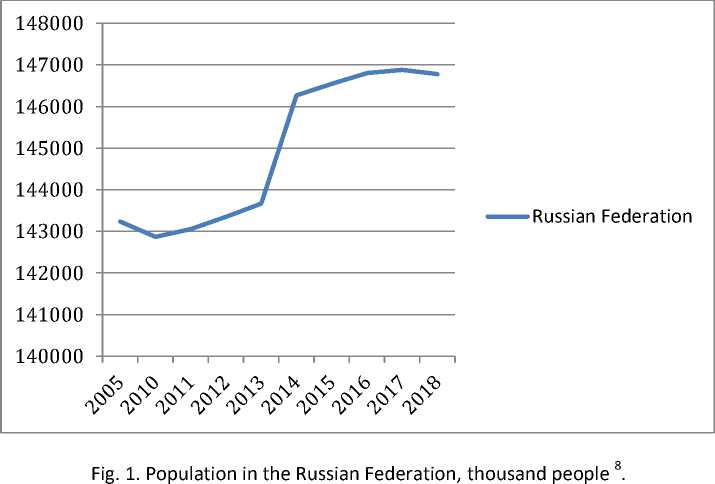
-
7 Federal'nyy zakon ot 13.07.2020 N 193-FZ «O gosudarstvennoy podderzhke predprinimatel'skoy deyatel'nosti v Ark-ticheskoy zone Rossiyskoy Federatsii» [Federal Law No. 193-FZ of July 13, 2020 “On state support for entrepreneurial activities in the Arctic Zone of the Russian Federation”]. URL: http://www.consultant.ru/document/cons_doc_LAW_357078/ (accessed 07 September 2020).
-
8 Compiled by the authors according to: Regions of Russia 2019. URL: https://rosstat.gov.ru/folder/210/document/13204 (accessed 07 December 2020).
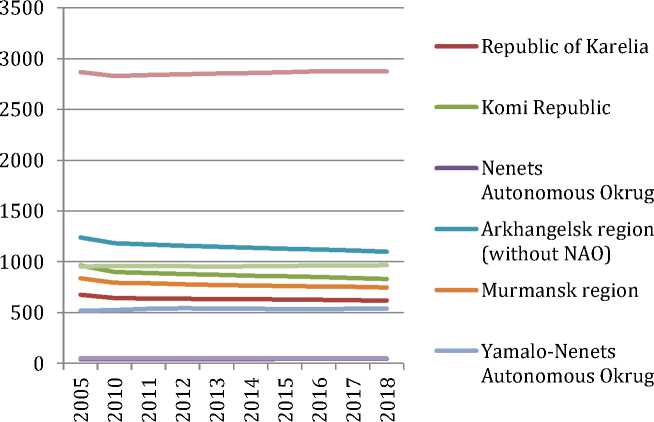
Fig. 2. Population in the Arctic zone of the Russian Federation, thousand people 9.
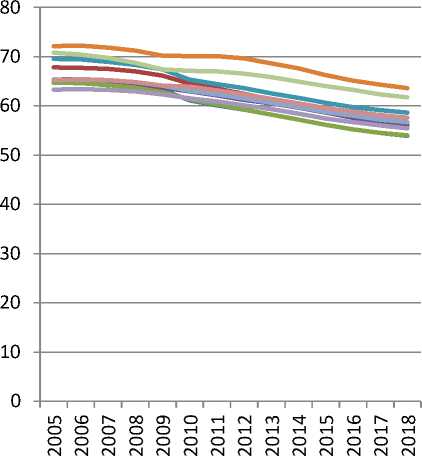
^^^^^w Republic of Karelia
^^^^^ ■ i Komi Republic
^^^^^eMurmansk region
^^^^^w Krasnoyarsk region
^^^^^eYamalo-Nenets
Autonomous Okrug
^^^^^wArkhangelsk region (without NAO)
• - Nenets Autonomous
Okrug
Fig. 3. The percentage of the working-age population in the regions of the Arctic zone, % 10.
As can be seen from Fig. 1, 2, 3, despite the increase in the population in the Russian Federation, most AZRF regions experienced a decline in population over the period under study. Despite the general decrease in population in most regions of the Russian Arctic, all regions of the Arctic Zone have observed a drop in the percentage of the working-age population, which means, in dynamics, a significant decrease in the labor force in these regions. The decline in number of able-bodied population is due to the lack of jobs and the poor state of housing and communal services, etc.
In the political area of the Russian Federation in the Arctic zone, there is a prevalence of solutions to the problems of large-scale commercial activities (oil and gas production) over socio- economic development [7, Klimentieva 2017, pp. 4–11].
Critical state of housing and communal services. Let us consider the share of dilapidated housing stock in the total area of the entire housing stock in Fig. 4.
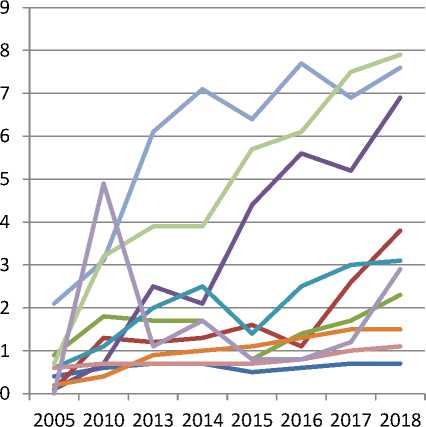
^^^^^ ■ iRussian Federation
Republic of Karelia
^^^^^eKomi Republic
' Nenets Autonomous
Okrug
• Arkhangelsk region
(without NAO)
^^^^^wMurmansk region
Fig. 4. The share of dilapidated housing stock in the total area of the entire housing stock, % 11.
As shown in Fig. 4, since 2014, the proportion of emergency housing on average in the Russian Federation is less than in the regions of the Arctic zone of the Russian Federation. This is due to the complexity of building, as well as low population density. One of the main factors in the social well-being of citizens is the provision of housing and residential infrastructure.
We also note that there are difficulties with water supply, sanitation and the supply of electrical energy in the Russian Arctic.
High cost of living and resource use . Let us consider the share of various expenses in the total amount of expenses in Fig. 5, 6, 7.
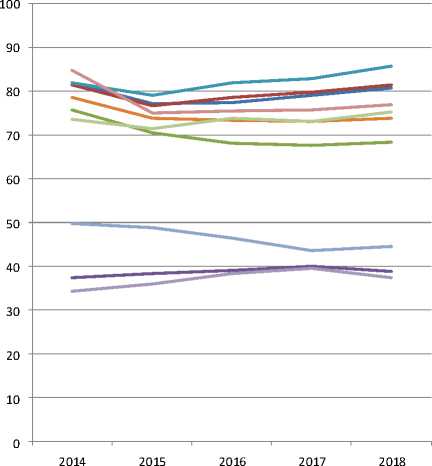
^^^^^™ Russian Federation
^^^^^™ Republic of Karelia
^^^^^™ Komi Republic
-
■ Nenets Autonomo us Okrug
^^^^^еArkhangelsk region (without NAO)
^^^^^™ Murmansk region
^^^^*Yamalo-Nenets Autonomous
Okrug
^^^^^™ Krasnoyarsk region
^^^^^е Republic of Sakha (Yakutia)
^^^^ ■ i Chukotka Autonomous Okrug
Fig. 5. The share of the purchase of goods and payment for services in the total volume of expenses 12.
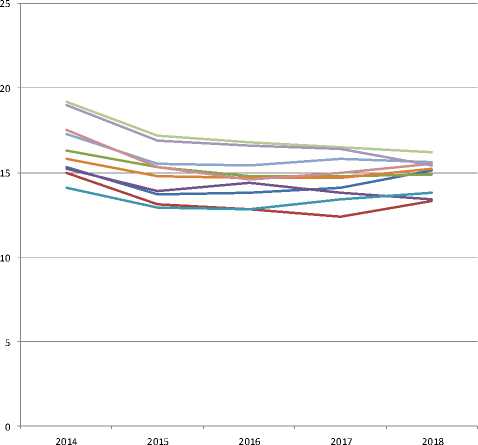
^^^^^е Russian Federation
- Republic of Karelia
- ^ Komi Republic
: - Nenets Autonomo us Okrug
^^^^^*Arkhangelsk region (without NAO)
■ л Murmansk region
: =Yamalo-Nenets Autonomous Okrug
■ = Krasnoyarsk region
1 —Republic of Sakha (Yakutia)
^^^^^е Chukotka Autonomous Okrug
Fig. 6. The share of mandatory payments and various contributions in the total volume of expenditures 13
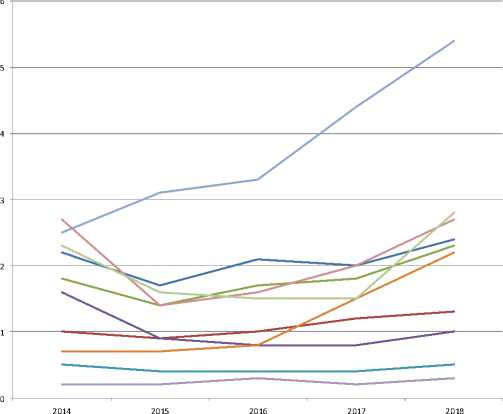
Russian Federation
Republic of Karelia
Komi Republic
Nenets Autonomous Okrug
^^^^wArkhangelsk region (without NAO)
^^^^w Murmansk region
Yamalo-Nenets Autonomous Okrug
Krasnoyarsk region
Republic of Sakha (Yakutia)
Chukotka Autonomous Okrug
Fig. 7. The share of expenses for the real estate purchase in the total amount of expenses
As shown in Fig. 5, 6, 7, in most regions of the Arctic zone, the share of expenses for the purchase of goods and payment for services is less than in the whole of the Russian Federation, the share of mandatory payments in most regions, on the contrary, is higher than the average for the Russian Federation. The share of expenses for the purchase of real estate in most AZRF regions is lower than the average for Russia.
Higher than the national average costs of production stimulate actions related to the search for solutions and methods leading to cost reduction.
Threats to environmental safety. At the international level, it is possible to note such dangerous ecological trends in the Arctic as the pollution caused by the sea transport wastes, a large number of objects that potentially pose a radiation hazard [8, Sharno O.I., pp. 53–58]. It is necessary to preserve the natural environment of the Arctic for present and future generations, for this purpose it is required to expand the network of protected areas, to dispose toxic waste [9, Knaub R.V., Shamaeva E.F., Popov E.B., pp. 5–37]. AZRF security is discussed mainly in a non-military framework. A significant role is played by the issue of climate change, in a narrower sense — damage to the ice layer and changes in weather conditions. In 2018, a landmark report by the Intergovernmental Panel on Climate Change described a temperature increase of 1.5°C.
State environmental policy in the Arctic zone is part of the national security. It is a set of various measures aimed at protecting the population and the natural environment of the Russian Arctic from negative factors, preventing environmental threats and creating environmental monitoring, risk assessment, and international cooperation in the environmental safety of the Arctic.
Environmental threats in the AZRF are a critical factor not only for the Arctic region of the Russian Federation, but also for the whole world. It is necessary to influence the natural environ-
-
14 Compiled by the authors according to: Regions of Russia 2019. URL:
(accessed 07 December 2020).
ment of the Arctic with the utmost care so as not to disturb the unique natural balance of this ar- ea.
Weak production diversification (emphasis on extractive industries). Let us consider the share of mining, manufacturing, transportation and storage in the total number of enterprises and organizations by type of economic activity in 2018 in Fig.8.
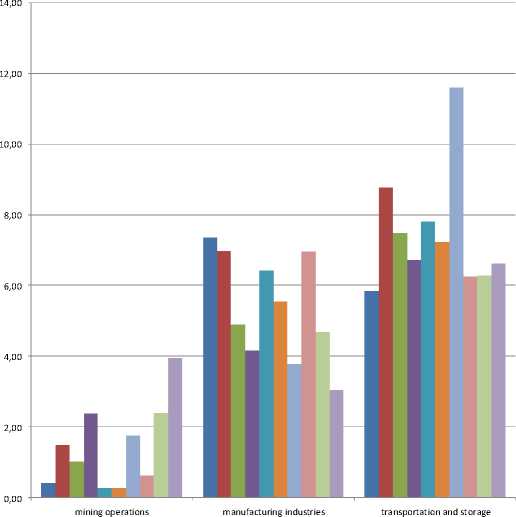
■ Russian Federation
■ Republic of Karelia
■ Komi Republic
■ Nenets Autonomous Okrug
■ Arkhangelsk region (without NAO)
■ Murmansk region
■ Yamalo-Nenets Autonomous Okrug
■ Krasnoyarsk region
Republic of Sakha (Yakutia)
■ Chukotka Autonomous Okrug
-
Fig. 8. The share of mining, manufacturing, transportation and storage in the total number of enterprises and organizations by type of economic activity in 2018 15
As shown in Fig. 8, the number of enterprises engaged in the extraction of minerals in most AZRF regions is greater than the average for Russia, and the number of manufacturing industries, on the contrary, is higher on average in Russia than in the regions of the Arctic zone. We also note the high proportion of organizations involved in transportation and storage in the AZRF, which means the possibility of processing minerals and creating jobs in the region.
Thus, for the rational activity of the Russian Arctic, it is necessary to develop other areas besides the extraction of resources.
Long distances from industrial centers and low population density . Let us consider the population density in the regions of the Arctic zone of the Russian Federation and in the Russian Federation as a whole for 2019 in Table 1.
Table 1
Population density in the regions of the Arctic zone of the Russian Federation and of the Russian Federation in the whole for 2019 16
|
№ |
Region |
Population density |
|
63 |
Murmansk Oblast |
5.12 |
|
67 |
Republic of Karelia |
3.4 |
|
70–71 |
Arkhangelsk Oblast without NAO |
2.64 |
|
75 |
Komi Republic |
1.97 |
|
79 |
Krasnoyarsk Krai |
1.21 |
|
80 |
Yamalo-Nenets Autonomous Okrug |
0.71 |
|
82 |
The Republic of Sakha (Yakutia) |
0.32 |
|
84 |
Nenets Autonomous Okrug |
0.25 |
|
85 |
Chukotka Autonomous Okrug |
0.07 |
|
RF |
8.57 |
Based on table 1, we reveal that the population density in the AZRF regions is significantly less than the average for the Russian Federation. Of the 85 regions in the ranking, the positions of the Arctic regions do not exceed 63 points.
Due to the large distances between settlements, there is a problem with employment, health care and education in remote areas. Some communities in the Russian Arctic are dying out due to the inability of the population to find work. There are also serious problems with health care and education in these areas, which also causes migration.
With an undeveloped transport infrastructure, small businesses may have problems with sales. Therefore, entrepreneurs are not determined to develop these settlements.
It is necessary to support small settlements by creating jobs, schools and health facilities. At the same time, one should not forget about the transport accessibility of these settlements.
It is worth noting that apart from the Russian Federation, there are other countries claiming the territory of the Arctic. In particular, new opportunities for resource extraction and emerging maritime routes between Europe, North America and Asia have increased the interest of various countries in the Arctic [5, Hawkin, pp. 1–4]. To understand that Russia is not alone in the Arctic, we note that 40% of Canada's territories are located in the Arctic [6, Byers, Lodge, pp. 103– 109]. The attitude of other countries towards their Arctic territories also deserves attention; for example, in Finland, the main Arctic development objective is tourism 17. Successful experience in tourism is shown by such territories as Greenland (Denmark) and Svalbard (Norway) 18.
Research results
Under the given conditions (the complexity of statistical observation, the lack of clearly de- fined goals), it becomes necessary to create a conceptual model for the development of the region. A conceptual model of balanced socio-economic development of the region, presented in
Figure 1, was built using a set of factors developed under the project No. АААА-А19-119020490098-1.
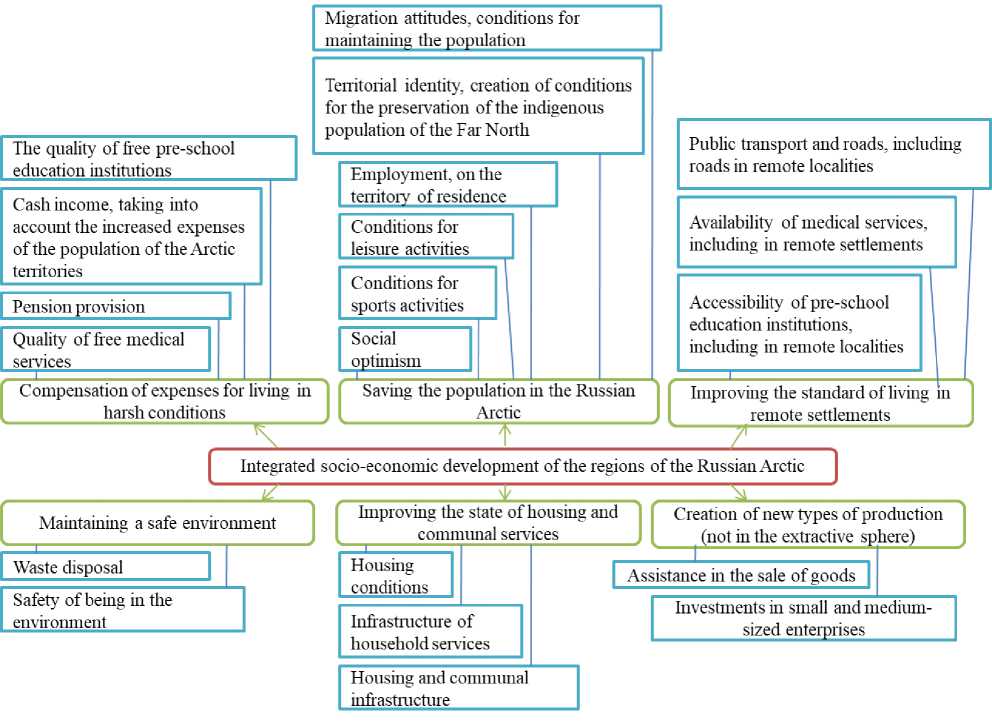
-
Fig. 9. Conceptual model of integrated socio-economic development of the Arctic regions.
It should be noted that these factors have different significance in influencing the development of the region. In order to assess their significance, it is planned to assign weighting coefficients based on the ranking of factors by experts in the course of regional surveys.
Let us turn to the justification of the choice of specific factors of socio-economic development and sets of indicators for their quantitative measurement. The population health is the basis of the quality of life.
Compensation of expenses for living in difficult conditions is necessary for the life standard of the population of the Russian Arctic to become higher and thus closer to the national average. Maintaining the population size is necessary for the AZRF development, while we note that social capital affects the reduction of transaction costs and, through this, economic growth [9, Milgrom P, Roberts J., p. 60]. The environment has a direct impact on the quality of life and health of the population. It is also necessary to develop remote settlements. The improvement of the housing and utilities sector affects the standard of living. Besides, new types of production will improve the competitiveness of the region and increase the number of jobs.
Conclusion
The regions of the Russian Arctic have great potential for creating processing industries and jobs in these industries, which can reduce migration and, as a result, population decline. Particular attention should be paid to the housing sector. Due to the harsh climate and low wages in the Arctic regions, mandatory payments have a large share of expenditure, which has a negative impact on the level of socio-economic development. It is also important to solve the problems of remote settlements (transport accessibility, employment, education, healthcare).
The regions of the Arctic zone deserve the most attention, since environmental disruption in these regions can affect the whole world, and it is very important to maintain the natural balance and combine it with a decent standard of living in the region.
It should be noted that numerical indicators are needed to assess the effectiveness of governance. If each of the factors of the conceptual model is assigned its own index, it is a good tool for assessing management effectiveness. At this stage of development, the model can help in determining the necessary directions in the field of socio-economic development of the region. Once again, it is necessary to take into account the multifactorial nature of regional development, where each factor is certainly important, but they are quite interconnected, and without the development of each of them it is impossible to achieve a comprehensive socio-economic development of the region.
The developed conceptual model will help to study the problems of the Arctic zone of the Russian Federation. This area of research is quite promising and understudied.
Список литературы On the Conceptual Model of Balanced Socio-Economic Development of the Arctic Territories
- Lundberg H., Pasillas M.R., Högberg A. Towards a Conceptual Model for Heritagepreneurship and Regional Development. Tourism and Culture in the Age of Innovation, 2016, pp. 23 40. DOI: 10.1007/978 3 319 27528 4_2
- Ignatova T.V., Pavlyukova A.V. Upravlenie konkurentnymi preimushchestvami organizatsiy Yuga Rossii [Management of the Competitive Advantages of Organizations in the South of Russia]. Konkuren-tosposobnost' v global'nom mire: ekonomika, nauka, tekhnologii [Competitiveness in the Global World: Economics, Science, Technologies], 2017, no. 11, vol. 9, pp. 1171 1173.
- Vaisman E.D., Boos V.O. Kontseptual'naya model' sistemy indikativnogo planirovaniya regional'nogo razvitiya ekonomiki znaniy [Regional Knowledge Economy Development Indicative Planning System Conceptual Model]. Ekonomika regiona [Economy of Region], 2012, no. 4 (32), pp. 130 139.
- Sukhareva E.O. Problemy osvoeniya Arkticheskikh regionov Rossii [Problems of Development of the Arctic Regions of Russia]. Vestnik nauki i obrazovaniya [Bulletin of Science and Education], 2019, no. 7 3 (61), pp. 43 45.
- Hawkin B. A Slow Thaw: Canada’s Evolving Arctic Defence Posture. Policy Brief, 2019, vol. 5, iss. 3, pp. 1 4.
- Byers M., Lodge E. China and the Canadian Arctic. Canada's Arctic Agenda: Into the Vortex, 2019, pp. 103 109.
- Klimentieva A.Yu. Kontseptual'naya model' razvitiya regional'noy innovatsionnoy podsistemy [The Conceptual Model of Development of the Regional Innovative Subsystem]. Regional'nye problemy preobrazovaniya ekonomiki [Regional Problems of Transforming the Economy], 2017, no. 10, pp. 4
- Sharno O.I. Arkticheskaya zona Rossiyskoy Federatsii: problemy pravovogo regulirovaniya i obespecheniya ekologicheskoy bezopasnosti [The Arctic Zone of the Russian Federation: Problems of Legal Regulation and Environmental Safety]. Nauchnyy vestnik Volgogradskogo filiala RANKhiGS. Ser.: Yurisprudentsiya [Scientific Herald of the Volgograd Branch of the Russian Presidential Academy of National Economy and Public Administration. Jurisprudence Series], 2019, vol. 5, no. 1, pp. 53 58.
- Knaub R.V., Shamaeva E.F., Popov E.B. Ustoychivoe regional'noe razvitie Arkticheskikh territoriy v kontekste bezopasnosti [Sustainable Regional Development of the Arctic Territories in the Context of Security]. Ustoychivoe innovatsionnoe razvitie: proektirovanie i upravlenie [Sustainable Innovative Development: Design and Management], 2019, vol. 15, no. 3 (44), pp. 5 37.
- Milgrom P., Roberts J. Ekonomika, organizatsiya i menedzhment: V 2 kh tomakh [Economics, Organi-zation and Management: in 2 volumes]. Moscow, 2004, vol. 1, 468 p. (In Russ.)

